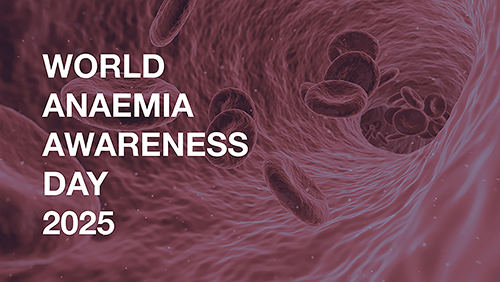World Anaemia Awareness Day
07. February 2025

%3Cp%3E%26nbsp%3B%3C%2Fp%3E%3Ch2%20style%3D%22text-align%3Acenter%3B%22%3EUnderstanding%20Anaemia%20and%20the%20Importance%20of%20World%20Anaemia%20Awareness%20Day%3C%2Fh2%3E%3Cp%3EIn%20line%20with%20Nihon%20Kohden%E2%80%99s%20goal%20of%20providing%20better%20medical%20solutions%20to%20address%20the%20needs%20of%20various%20laboratories%2C%20the%20%3Ca%20href%3D%22https%3A%2F%2Feu.nihonkohden.com%2Fivd-solutions%22%3EClinical%20Laboratory%20line%20%3C%2Fa%3Eof%20products%20encompasses%20a%20range%20of%20Haematology%20Analysers%20that%20provide%20user-friendly%20solutions%20that%20are%20simple%20to%20use%20while%20improving%20efficiency%20and%20streamlining%20workflow.%20These%20solutions%20support%20the%20diagnosis%20of%20a%20range%20of%20patient%20conditions%2C%20including%20Anaemia%2C%20Leukaemia%20and%20infections%2C%20ensuring%20better%20patient%20outcomes.%26nbsp%3B%3Cbr%3EAnaemia%20is%20a%20common%20yet%20often%20overlooked%20condition%20that%20affects%20millions%20of%20people%20worldwide.%20It%20occurs%20when%20your%20body%20doesn%27t%20have%20enough%20healthy%20red%20blood%20cells%20to%20carry%20adequate%20oxygen%20to%20your%20tissues%2C%20leading%20to%20symptoms%20like%20fatigue%2C%20weakness%2C%20and%20shortness%20of%20breath.%20There%20are%20various%20types%20of%20anaemia%2C%20with%20iron-deficiency%20anaemia%20being%20the%20most%20prevalent.%3Cbr%3EGlobally%2C%20in%202021%2C%20the%20global%20incidence%20of%20anaemia%20was%2024.3%25%20which%20makes%20up%20to%201.92%20billion%20people.%20%26nbsp%3B%20It%20was%20reported%20that%2031.2%25%20of%20women%20had%20anaemia%20compared%20with%2017.5%25%20of%20men.%20This%20gender%20gap%20is%20more%20apparent%20when%20we%20look%20at%20the%20reproductive%20age%20group%20of%2015%20to%2049%20years%20old.%20In%20this%20age%20group%2C%20anaemia%20prevalence%20in%20women%20was%2033.7%25%2C%20while%20it%20was%2011.3%25%20in%20men%3Cspan%20style%3D%22font-family%3A%26quot%3BAptos%26quot%3B%2Csans-serif%3Bfont-size%3A12.0pt%3Bline-height%3A115%25%3B%22%20lang%3D%22EN-GB%22%3E%3Csup%3E1%3C%2Fsup%3E%3C%2Fspan%3E.%3C%2Fp%3E%3Ch4%3ESymptoms%20of%20Anaemia%3C%2Fh4%3E%3Cp%3EWhile%20the%20symptoms%20of%20anaemia%20can%20vary%20based%20on%20the%20cause%20and%20severity%2C%20common%20symptoms%20include%3Cspan%20style%3D%22font-family%3A%26quot%3BAptos%26quot%3B%2Csans-serif%3Bfont-size%3A12.0pt%3Bline-height%3A115%25%3B%22%20lang%3D%22EN-GB%22%3E%3Csup%3E2%3C%2Fsup%3E%3C%2Fspan%3E%3A%3Cbr%3E-%20Fatigue%20and%20weakness%3Cbr%3E-%20Pale%20or%20yellowish%20skin%3Cbr%3E-%20Irregular%20heartbeats%3Cbr%3E-%20Shortness%20of%20breath%3Cbr%3E-%20Dizziness%20or%20light-headedness%3Cbr%3E-%20Cold%20hands%20and%20feet%3C%2Fp%3E%3Ch4%3EWhat%20Causes%20Anaemia%3F%3C%2Fh4%3E%3Cp%3EAnaemia%20can%20result%20from%20several%20factors%2C%20including%3A%3Cbr%3E%E2%80%A2%26nbsp%3B%26nbsp%3B%26nbsp%3B%26nbsp%3BIron%20deficiency%3A%20The%20most%20common%20cause%2C%20often%20due%20to%20inadequate%20dietary%20intake%20or%20chronic%20blood%20loss.%3Cbr%3E%E2%80%A2%26nbsp%3B%26nbsp%3B%26nbsp%3B%26nbsp%3BVitamin%20deficiency%3A%20Lack%20of%20vitamin%20B12%20or%20folate%20can%20lead%20to%20anaemia.%3Cbr%3E%E2%80%A2%26nbsp%3B%26nbsp%3B%26nbsp%3B%26nbsp%3BChronic%20diseases%3A%20Conditions%20like%20kidney%20disease%20or%20cancer%20can%20interfere%20with%20red%20blood%20cell%20production%2C%20leading%20to%20anaemia.%3Cbr%3E%E2%80%A2%26nbsp%3B%26nbsp%3B%26nbsp%3B%26nbsp%3BGenetic%20disorders%3A%20Diseases%20such%20as%20sickle%20cell%20anaemia%20or%20thalassemia%20are%20inherited%20and%20affect%20red%20blood%20cell%20production.%3C%2Fp%3E%3Ch4%3EDiagnostic%20Tests%20for%20Anaemia%3C%2Fh4%3E%3Cp%3EAlongside%20physical%20presentations%20of%20anaemia%2C%20diagnostics%20tests%20also%20play%20a%20role%20in%20identifying%20the%20type%20and%20cause%20of%20the%20condition.%20The%20common%20tests%20utilized%20in%20diagnosis%20are%3Cspan%20style%3D%22font-family%3A%26quot%3BAptos%26quot%3B%2Csans-serif%3Bfont-size%3A12.0pt%3Bline-height%3A115%25%3B%22%20lang%3D%22EN-GB%22%3E%3Csup%3E3%2C4%3C%2Fsup%3E%3C%2Fspan%3E%3A%3Cbr%3E%3Cstrong%3E%E2%80%A2%26nbsp%3B%26nbsp%3B%26nbsp%3B%26nbsp%3BComplete%20Blood%20Count%20%28CBC%29%3C%2Fstrong%3E%3Cbr%3Eo%26nbsp%3B%26nbsp%3B%26nbsp%3B%26nbsp%3BThe%20CBC%20is%20the%20most%20common%20test%20used%20in%20the%20diagnosis%20of%20anaemia.%20It%20measures%20the%20levels%20of%20red%20blood%20cells%2C%20white%20blood%20cells%2C%20haemoglobin%2C%20and%20platelets%20in%20a%20blood%20sample%20using%20an%20analyser%20like%20the%20Nihon%20Kohden%20Automated%20Hematology%20Analyzers.%3Cbr%3E%3Cstrong%3E%E2%80%A2%26nbsp%3B%26nbsp%3B%26nbsp%3B%26nbsp%3BReticulocyte%20Count%3C%2Fstrong%3E%3Cbr%3Eo%26nbsp%3B%26nbsp%3B%26nbsp%3B%26nbsp%3BThis%20test%20measures%20the%20number%20of%20immature%20red%20blood%20cells%20in%20your%20blood%2C%20helping%20to%20determine%20if%20your%20bone%20marrow%20is%20producing%20enough%20red%20blood%20cells.%20Many%20analysers%20offer%20this%20as%20part%20of%20their%20CBC%20panel%20and%20it%20is%20available%20on%20the%20Nihon%20Kohden%20MEK-9200%20Automated%20Heamatology%20Analyser.%3Cbr%3E%3Cstrong%3E%E2%80%A2%26nbsp%3B%26nbsp%3B%26nbsp%3B%26nbsp%3BPeripheral%20Blood%20Smear%3C%2Fstrong%3E%3Cbr%3Eo%26nbsp%3B%26nbsp%3B%26nbsp%3B%26nbsp%3BThis%20test%20examines%20the%20size%2C%20shape%2C%20and%20color%20of%20your%20red%20blood%20cells%20under%20a%20microscope.%20The%20information%20from%20this%20test%20assists%20in%20identifying%20any%20abnormalities%20in%20cells%2C%20that%20could%20indicate%20the%20cause%20of%20anaemia.%3Cbr%3E%3Cstrong%3E%E2%80%A2%26nbsp%3B%26nbsp%3B%26nbsp%3B%26nbsp%3BIron%20Panel%3C%2Fstrong%3E%3Cbr%3Eo%26nbsp%3B%26nbsp%3B%26nbsp%3B%26nbsp%3BAn%20Iron%20Panel%20measures%20the%20levels%20of%20iron%20in%20your%20blood%2C%20including%20ferritin%2C%20serum%20iron%2C%20transferrin%20saturation%2C%20and%20total%20iron-binding%20capacity.%20This%20information%20helps%20in%20identifying%20iron-deficiency%20anaemia%3Cbr%3E%3Cstrong%3E%E2%80%A2%26nbsp%3B%26nbsp%3B%26nbsp%3B%26nbsp%3BVitamin%20B12%20and%20Folate%20Tests%3C%2Fstrong%3E%3Cbr%3Eo%26nbsp%3B%26nbsp%3B%26nbsp%3B%26nbsp%3BVitamin%20related%20tests%20measure%20the%20levels%20of%20vitamin%20B12%20and%20folate%20in%20your%20blood%2C%20which%20are%20essential%20for%20red%20blood%20cell%20production.%20This%20information%20helps%20in%20identifying%20vitamin%20deficiency%20anaemia%26nbsp%3B%3Cbr%3E%3Cstrong%3E%E2%80%A2%26nbsp%3B%26nbsp%3B%26nbsp%3B%26nbsp%3BHemoglobin%20Electrophoresis%3C%2Fstrong%3E%3Cbr%3Eo%26nbsp%3B%26nbsp%3B%26nbsp%3B%26nbsp%3BThis%20test%20identifies%20different%20types%20of%20haemoglobin%20in%20your%20blood%2C%20which%20can%20help%20diagnose%20genetic%20disorders%20like%20sickle%20cell%20anaemia.%3C%2Fp%3E%3Ch4%3EWorld%20Anemia%20Awareness%20Day%3C%2Fh4%3E%3Cp%3ECelebrated%20on%20February%2013th%2C%20World%20Anemia%20Awareness%20Day%20was%20established%20to%20highlight%20the%20global%20impact%20of%20anemia%20and%20iron%20deficiency%2C%20particularly%20among%20women%20and%20children%3Ci%3E%3Cspan%20style%3D%22font-family%3A%26quot%3BAptos%26quot%3B%2Csans-serif%3Bfont-size%3A12.0pt%3Bline-height%3A115%25%3B%22%20lang%3D%22EN-GB%22%3E%3Csup%3E5%3C%2Fsup%3E%3C%2Fspan%3E%3C%2Fi%3E.%20This%20day%20serves%20as%20a%20platform%20to%20educate%20the%20public%20about%20the%20importance%20of%20blood%20health%20and%20the%20need%20for%20preventive%20measures.%3Cbr%3EWorld%20Anemia%20Awareness%20Day%202025%20kicks%20off%20with%20a%2024%20hour%20Global%20Anemia-thon%20event.%20The%20theme%20of%20%E2%80%9CRaise%20Your%20Hands%20for%20Blood%20Health%E2%80%9D%20aims%20to%20promote%20the%20critical%20role%20of%20preventative%20action%20to%20support%20blood%20health.%3C%2Fp%3E%3Ch4%3EHere%E2%80%99s%20How%20You%20Can%20Participate%20in%20World%20Anemia%20Awareness%20Day%3C%2Fh4%3E%3Cp%3E1.%26nbsp%3B%26nbsp%3B%26nbsp%3B%26nbsp%3BEducate%20yourself%20and%20others%20about%20the%20causes%2C%20symptoms%2C%20and%20treatments%20of%20anaemia.%20Share%20this%20knowledge%20with%20friends%20and%20family.%3Cbr%3E2.%26nbsp%3B%26nbsp%3B%26nbsp%3B%26nbsp%3BDonate%20blood%20at%20your%20local%20Blood%20Bank.%20Blood%20donation%20can%20help%20save%20lives%20and%20raise%20awareness%20about%20the%20importance%20of%20blood%20health.%3Cbr%3E3.%26nbsp%3B%26nbsp%3B%26nbsp%3B%26nbsp%3BSupport%20local%20organizations%20that%20are%20working%20on%20fighting%20anaemia%20and%20promoting%20blood%20health.%3Cbr%3E4.%26nbsp%3B%26nbsp%3B%26nbsp%3B%26nbsp%3BPromote%20healthy%20eating%3A%20Encourage%20a%20diet%20rich%20in%20iron%2C%20vitamin%20B12%2C%20and%20folate%20to%20help%20prevent%20anaemia.%3C%2Fp%3E%3Ch4%3ERaise%20Your%20Hands%20for%20Blood%20Health%3C%2Fh4%3E%3Cp%3EWith%20Anaemia%20still%20being%20a%20significant%20public%20health%20issue%2C%20bringing%20attention%20to%20its%20importance%20and%20the%20increasing%20awareness%20of%20the%20causes%20related%20to%20it%20is%20essential.%20By%20participating%20in%20World%20Anemia%20Awareness%20Day%2C%20you%20can%20help%20raise%20your%20hands%20for%20blood%20health%20and%20contribute%20to%20the%20fight%20against%20this%20condition.%20Remember%2C%20the%20best%20blood%20is%20your%20blood%2C%20so%20take%20care%20of%20it%20by%20staying%20informed%20and%20proactive%20about%20your%20health.%3C%2Fp%3E%3Cp%3E%3Cspan%20class%3D%22text-small%22%3E%3Cstrong%3EReferences%3C%2Fstrong%3E%3C%2Fspan%3E%3Cbr%3E%3Cspan%20class%3D%22text-small%22%3E1.%26nbsp%3B%26nbsp%3B%26nbsp%3B%26nbsp%3BMeasuring%20the%20global%20burden%20of%20anaemia.%20Pasricha%2C%20Sant-Rayn%20et%20al.%20The%20Lancet%20Haematology%2C%20Volume%2010%2C%20Issue%209%2C%20e696%20-%20e697%3C%2Fspan%3E%3Cbr%3E%3Cspan%20class%3D%22text-small%22%3E2.%26nbsp%3B%26nbsp%3B%26nbsp%3B%26nbsp%3Bhttps%3A%2F%2Fwww.mayoclinic.org%2Fdiseases-conditions%2Fanemia%2Fdiagnosis-treatment%2Fdrc-20351366%3C%2Fspan%3E%3Cbr%3E%3Cspan%20class%3D%22text-small%22%3E3.%26nbsp%3B%26nbsp%3B%26nbsp%3B%26nbsp%3BTefferi%20A%2C%20Hanson%20CA%2C%20Inwards%20DJ.%20How%20to%20interpret%20and%20pursue%20an%20abnormal%20complete%20blood%20cell%20count%20in%20adults.%20Mayo%20Clin%20Proc.%202005%20Jul%3B80%287%29%3A923-36.%20doi%3A%2010.4065%2F80.7.923.%20PMID%3A%2016007898%3B%20PMCID%3A%20PMC7127472.%3C%2Fspan%3E%3Cbr%3E%3Cspan%20class%3D%22text-small%22%3E4.%26nbsp%3B%26nbsp%3B%26nbsp%3B%26nbsp%3BButtarello%2C%20M.%20%282016%29%2C%20Laboratory%20diagnosis%20of%20anemia%3A%20are%20the%20old%20and%20new%20red%20cell%20parameters%20useful%20in%20classification%20and%20treatment%2C%20how%3F.%20Int.%20Jnl.%20Lab.%20Hem.%2C%2038%3A%20123-132.%20https%3A%2F%2Fdoi.org%2F10.1111%2Fijlh.12500%3C%2Fspan%3E%3Cbr%3E%3Cspan%20class%3D%22text-small%22%3E5.%26nbsp%3B%26nbsp%3B%26nbsp%3B%26nbsp%3Bhttps%3A%2F%2Fworldanemiaawareness.com%2Fabout-world-anemia-awareness-day%2F%3C%2Fspan%3E%3Cbr%3E%26nbsp%3B%3C%2Fp%3E%3Cp%3E%26nbsp%3B%3C%2Fp%3E